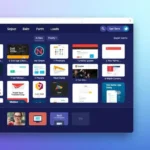Many users experience the problem of apps not showing up in Google Chrome, which can be confusing. People wonder why some apps don’t appear in Chrome.
We will investigate why this happens and explore the challenges with Chrome’s app setup and visibility. Knowing the reasons will help us solve missing or broken Chrome apps.
This guide is for everyone, whether you’re a developer or just a user. It will help you ensure that your Chrome apps are always visible and work well.
Exploring Chrome’s App Visibility Issues
Finding an app on Chrome can be challenging due to visibility issues. This problem, known as “Chrome app visibility issues,” can be quite frustrating. However, we’re here to help you understand why some apps may not appear.
Understanding the Potential Causes
One big reason apps might not appear is if they’re set up incorrectly. Chrome has certain rules for apps to work well. If an app doesn’t follow these rules, it might not work properly with the browser.
Also, Chrome extensions not showing could be due to Chrome’s safety and privacy rules. These rules might block some apps, even if they work fine.
Identifying the Contributing Factors
- Incompatible app packaging or deployment methods
- Conflicts with Chrome’s security and privacy policies
- User-specific settings that impact app visibility
- Outdated or unsupported app versions
- Temporary glitches or Chrome browser issues
Knowing what causes Chrome app visibility issues is the first step to fixing them. By figuring out why apps might not show up, you can ensure your important apps are always there when needed.
“Visibility is one of the most important factors when it comes to the success of any application, especially in the digital age.”
Chrome’s App Deployment and Packaging Challenges
Developing apps for Google Chrome comes with its own set of hurdles. To ensure your app works well, you must follow Chrome’s specific rules. Knowing the different types of Chrome apps is a big step in tackling these issues.
When it comes to Chrome apps, how you package them matters a lot. You need to follow Chrome’s rules closely. Your app might not appear or work right in Chrome if you don’t.
- Make sure your app is packaged correctly for Chrome.
- Learn about the different Chrome apps and their special needs.
- Keep up with Chrome’s app deployment changes to avoid problems.
“Successful Chrome app deployment requires a thorough understanding of the platform’s unique packaging and integration guidelines.”
How visible your Chrome app is can also be a problem. The app’s manifest file and how you share it can affect this. Fixing these issues is key to making your app easy to find and use.
Developers can make their apps work well in Chrome by understanding and following its app deployment rules. Being informed and proactive can help your app reach its full potential on Chrome.
Troubleshooting Missing Chrome Web Apps
If you’re having trouble with missing Chrome web apps, you’re not alone. Many things can cause this problem, like app deployment issues or Chrome’s settings. We’ll help you find and fix the problem so your apps reappear.
Diagnosing the Root Cause
To start fixing missing Chrome web apps, discover why they’re gone. Check if the app was set up right for Chrome. Ensure the app’s manifest file and all needed files are there.
Then, look at Chrome’s app settings. Make sure your app is turned on and visible. Chrome’s settings can affect your app if it shows up, so check them carefully.
Implementing Effective Solutions
After finding the problem, it’s time to fix it. If the problem is with how the app was set up, change it to meet Chrome’s needs.
If it’s Chrome’s settings, adjust them to show your app. You might need to change settings, clear the cache, or reinstall the app. This ensures Chrome knows it’s there.
Following these steps can fix Chrome app visibility issues, ensuring that your Chrome web apps appear for your users.
“Troubleshooting missing Chrome web apps can be a frustrating experience, but with the right approach, you can quickly resolve the issue and ensure your apps are properly displayed.”
Why do some of my apps not show up in Chrome?
If you use Chrome, you will lose or have apps working incorrectly. This is a common problem. Identifying why it occurs can fix it.
The main reason is Chrome’s app visibility and policy. Chrome is in control of what apps it shows. It is very common in case of Chrome apps that aren’t displaying properly and this is especially the case.
What about app deployment and packaging? If it is not done properly, Chrome won’t see it. Chrome settings will influence which apps you view, so why do not all my apps show up in Chrome?
- Chrome’s selective app store and API (code-level) guidelines
- Embedded Chrome app deployment and packaging problem.
- User-specific Chrome settings and configurations
“Trying to figure out the missing Chrome apps is a bit of a puzzle, but knowing what is causing it means that you can move forward and fix it,” they said.
Learning why Chrome app visibility is not working and why Chrome apps don’t load helps fix it. That way, you’ll have all the apps you use most on hand in Chrome.
Resolving Chrome App Launch Failures
Launching a Chrome app smoothly is key to its success. But sometimes, launch failures can happen, leaving users stuck and unable to use their apps. We’ll explore how to fix these issues and ensure your Chrome apps work immediately.
Examining the Launch Process
Knowing the launch steps is crucial to tackling launch failures. It starts when a user opens the app. The Chrome browser then checks the app’s files, permissions, and more. Finding out where things go wrong helps solve the problem.
Addressing Common Launch Errors
Launch failures can come from many sources, like app settings or compatibility issues. Knowing the usual errors helps us fix them. Here are some common ones:
- Checking the app’s file for errors or missing info
- Ensuring the app’s permissions are correct
- Looking for conflicts with other Chrome apps
- Fixing Chrome app display errors that stop the app from opening
Following these steps can often fix the Chrome app launch failure and get your app running smoothly again.
“The key to resolving Chrome app launch failures lies in understanding the underlying processes and addressing the root causes of the problems.”
Chrome Extension Visibility Problems
Chrome extensions can improve your browsing, but sometimes, they’re hard to find. You might wonder, “Why aren’t my Chrome extensions showing up?” Don’t worry—we’re here to help. We’ll guide you through Chrome extension visibility and offer tips to fix display issues.
Chrome’s strict security policies can hide extensions. Chrome focuses on keeping users safe. This means extensions must meet certain standards to be seen and used.
- Improper extension packaging: If the extension’s files are not properly packaged or structured, Chrome may not recognize them as valid extensions, resulting in a Chrome extension not showing a scenario.
- Conflicting permissions: Chrome extensions require specific permissions to function, and if these permissions are not properly configured or conflict with other installed extensions, the extension may not be visible or operational.
- Extension compatibility issues: As Chrome is continuously updated, older extensions may become incompatible, leading to troubleshooting Chrome app display challenges.
Check your extension for the resolution of these Chrome app problem solutions. Be sure it is current and does not conflict with any other extensions. Deactivate and re-enable the extension, clear the browser cache, or reinstall it to get out of the problem.
“Chrome app visibility is not a fun task, but if you know what to do you will fix your extensions and have a smooth experience browsing”.
Chrome’s security emphasis might hide extensions. But if you understand why and apply the proper fixes, you can still have your extensions showing up and working.
Optimizing Chrome App Display Settings
If you’re having trouble with Chrome app display issues or your Chrome web app isn’t showing up, it’s time to tweak your settings. By adjusting the right preferences and making sure apps are visible, you can ensure they appear right in the Chrome browser.
Configuring Display Preferences
First, check your Chrome app’s display settings. Make sure everything is set up right for Chrome. You might need to tweak the app’s manifest file, check how it’s packaged and deployed, and confirm it’s listed in the Chrome Web Store.
Enabling App Visibility
- Check to see if your Chrome app is visible to everyone and if it’s set to be public and accessible.
- Think about changing the app’s permissions and access controls to help it show up better.
- Double-check that the app’s icons, screenshots, and other visuals appear in the Chrome Web Store.
By optimizing your Chrome app display settings, you can fix any Chrome app display problems or Chrome web app not showing issues. This way, your apps will be easy for users to find and use.
“Ensuring your Chrome apps are properly visible and accessible is crucial for user engagement and adoption.”
Debugging Chrome App Visibility Errors
If your Chrome apps aren’t showing up as expected, don’t worry – we’ve got you covered. Troubleshooting Chrome app visibility issues can be tricky. But by following a systematic approach, you can quickly find and fix the problems.
First, let’s look at why these visibility errors happen. They might be due to how the app is deployed and packaged or Chrome’s app management settings. By understanding these factors, we can find effective solutions to ensure your Chrome apps are shown correctly.
Diagnosing the Root Cause
To find the main issue, start by checking the app’s deployment. Make sure the app is correctly packaged and uploaded to the right places. Chrome’s app visibility policies and requirements can be strict, so checking your app’s compliance is crucial.
- Verify that the app’s manifest file is correctly configured and includes all the necessary details.
- Check for any conflicts or compatibility issues with Chrome’s app management system.
- Examine the app’s launch sequence to identify any potential bottlenecks or errors.
By carefully checking each area, you’ll find the root cause of the visibility problem. Then, you can take the right steps to fix it.
Implementing Effective Solutions
Once you know the source of the issue, it’s time to create a plan. The solution might involve tweaking the app’s packaging, modifying the manifest file, or adjusting Chrome’s app visibility settings. Remember, the key is to address the problem at its core, not just apply a temporary fix.
- Optimize the app’s packaging to ensure it meets Chrome’s requirements.
- Update the manifest file with the correct information and permissions.
- Explore Chrome’s app management settings and make any necessary adjustments.
By following these steps, you can resolve Chrome app display errors and ensure that your Chrome apps are visible to your users.
“Persistence and determination alone are omnipotent.” – Calvin Coolidge
Best Practices for Chrome App Deployment
When deploying Chrome apps, it’s key to ensure they are visible and work well. By using best practices, you can avoid common problems, and users will have a great experience using your app.
Ensuring Seamless App Visibility
To make your Chrome apps easy to find, follow these steps:
- Make sure your app’s title, description, and keywords are well-optimized. This helps it show up more in the Chrome Web Store.
- Keep your app up to date. This fixes any issues and keeps it visible as Chrome changes.
- Use Chrome’s app promotion tools. These can help your app get more attention.
- Talk to your users, listen to their feedback, and fix any problems. This keeps your app’s reputation high and visible.
Maintaining App Compatibility
Keeping your Chrome apps working with the latest Chrome versions is vital. This ensures a smooth experience for users. Here’s how to stay compatible:
- Watch Chrome’s updates and update your app to match. This fixes any issues or new features.
- Test your app on different browsers and devices. This finds and fixes any problems early.
- Use Chrome’s tools to find and fix any issues that come up.
- Keep up with Chrome’s plans. Plan your app’s updates to match the platform’s growth.
By following these tips, you can avoid visibility and compatibility problems. This ensures your app works well and users enjoy using it on Chrome.
“Successful Chrome app deployment requires a combination of strategic planning, diligent testing, and ongoing maintenance to ensure your app remains visible and compatible as the platform evolves.”
Conclusion
In this article, we looked at why some Chrome apps do not show up, and we went over issues like deployments and app settings that can keep your apps out of Chrome.
And you know now how to solve these issues. You can make your apps easy to access and navigate. You can use our guide to resolve your problems, such as my apps not showing up in Chrome, Chrome apps not showing up, Chrome apps not showing up, and Chrome app display problems.
You also want to make sure your Chrome apps are up and running. This will make users feel satisfied and find your apps easily. You can solve any Chrome app visibility issues as you learn the steps mentioned in this article. So, your apps will always be accessible in Google Chrome.
FAQ
Why do some of my apps not show up in Chrome?
There are many reasons why some apps might not appear in Google Chrome. Issues with how the app was made or packaged can be a problem. Also, Chrome’s own rules and your settings can affect visibility.
How can I troubleshoot missing Chrome web apps?
To find out why your Chrome web apps are missing, you need to figure out the main issue. Look at how the app was made and packaged, or see if Chrome’s settings are the problem. Once you know the cause, you can fix it and make your apps reappear.
What are some common challenges with Chrome’s app deployment and packaging?
Getting apps ready for Chrome can be tricky. Developers must make sure their apps work well with Chrome. Knowing the different types of Chrome apps and how to deploy them is key to avoiding problems.
How can I resolve Chrome app launch failures?
To fix Chrome app launch failures, understand how apps start in Chrome. Look for common errors and fix them. This way, you can get your Chrome apps to work right.
Why are my Chrome extensions not showing?
Chrome extension issues can come from many places. Problems with the extension itself, Chrome, or Chrome’s settings can hide them. By finding and fixing these problems, you can make your extensions visible again.
How can I optimize my Chrome app display settings?
Adjust your settings to improve the look of your Chrome apps. Make sure your apps meet Chrome’s needs and tweak display options. This will make your apps easy to find in Chrome.
What are some best practices for Chrome app deployment?
For smooth app deployment, follow some key steps. Properly package and share your apps, and follow Chrome’s guidelines. This keeps your apps working well and visible in Chrome.





